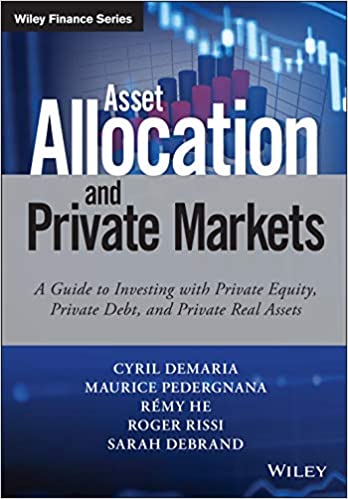
This is a book review of Asset Allocation & Private Markets: A Guide to Investing with Private Equity, Private Debt, and Private Real Assets is a book published by Cyril Demaria, Maurice Pedergnana, Remy Hé, Roger Rissi and Sarah Debrand.
Yes, a large ensemble! The size of this roster manifests itself in a rich rewarding text about the many diverging aspects of private market investments.
The book is published by John Wiley & Sons, as part of the Wiley Finance Series. The 1st edition was released on 25 February 2021.
We’ve reviewed many technical investment titles from the Wiley Finance Series on Financial Expert, as this publisher has really leaned into niche investment topics for the last 10-15 years, and has a wide-ranging collection of titles, covering topics such as inflation, investing in emerging markets, stakeholder capitalism and more.
About the authors of Asset Allocation & Private Markets
Cyril Demaria is a general partner and president of the Pilot Fish Funds, a series of venture capital finder’s funds for family offices and high net worth individuals. Previously, in charge of private markets research for UBS Wealth Management. He brings a wealth of listed private equity experience to this book.
Professor Dr. Maurice Pedergnana holds a dual-role as head of investment committee and chief economist at Zugerberg Finanz AG. He’s also the MD of the Swiss Private Equity & Corporate Finance Association.
Remy Hé is an analyst at Obviam, a Swiss investment firm specialising in private markets investments in emerging & frontier markets.
Roger Rissi is a lecturer at the Lucerne University of Applied Sciences. He researches advanced capital market and portfolio theory, corporate finance, risk management and asset allocation.
Sarah Debrand is a high-achieving French capital markets analyst at Citi Bank, based in London.
Book at a glance: the themes of Asset Allocation & Private Markets
Asset Allocation and Private Markets is a 286-page hardback covering the world of private markets, also known as unquoted investments, or the intrigue-inducing term ‘alternative assets’.

Shining light on a dark industry
Drawing from an impressive range of academic sources and difficult-to-get datasets, the authors bring insights in spades to this dark corner of the investing world.
Because private markets are by their nature, private, little data about transactions is readily available. Sure, VCTs and Private Equity houses like to spin out some press releases following a large acquisition or a profitable disposal, but how reliable is this information?
Even though these releases are a primary source, they aren’t as consistent as regulatory filings (which have a minimum level of disclosure), and their discretionary release means that they are certainly not representative of all transactions. Firms are inclined to talk loudly about their successes and quietly (if at all) about their failures.
That’s why a book like Asset Allocation and Private Markets brings much needed clarity to this opaque asset class.
A comprehensive introduction for beginners
This is a title that is built for a wide range of readers. I welcomed the extensive efforts to ensure that new readers wouldn’t be left in the dark. Over 30 pages of glossary sit at the back of the book, ready to offer a quick explanation for a multitude of technical words, acronyms and phrases. Invaluable for some readers, and yet unobtrusive for professionals working their way through the main text. Asset Allocation and Private Markets strikes a good balance between being technical, and being accessible.
Introduction to private markets. Ever wondered how venture capital, seed investment funds, business angels and Leverage Buy-Out (LBO) funds all have their own distinct space within the equity investment sphere? There’s a fantastic chart on page 58 that will help you visualise and make sense of this.
How to construct a portfolio of private market investments which takes a market-neutral stance?
Review of Asset Allocation & Private Markets
Financial Expert Rating: 4.5/5

As an investor who is always looking for something different to diversify into, and who understands the high risks of alternative investments, I’ve always been attracted to books like this which help to demystify asset classes that previously felt out of reach.
This is a serious book for either serious investors or wealth management professionals looking to get their head around the structure, risks and returns of private markets.
Buy this book to find out
- What steps should an investor follow in setting up a portfolio of alternative assets?
- What is the minimum time horizon for a private market investment?
- Given the sizeable correlation between private market investments and the business / financial cycle, Is effective market timing possible when managing a private asset portfolio?
Buy on Amazon now: Asset Allocation & Private Markets: A Guide to Investing with Private Equity, Private Debt, and Private Real Asset
Book rankings for similar topics & genres
Asset Allocation and Private Markets covers the follow topics: